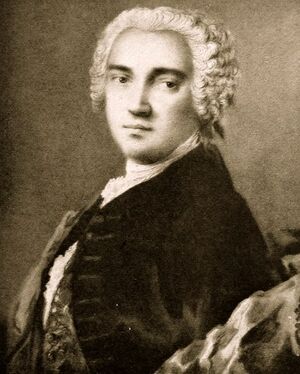Johann Adolph Hasse
Johann Adolph Hasse (Italianized Giovanni Adolfo; baptized March 25, 1699, † December 16, 1783) was an influential German composer of the late Baroque period. His fame during his lifetime was based mainly on his operas in the Italian style.
Life
Hasse started out as a singer, becoming a tenor at the Theater am Gänsemarkt in Hamburg. At the same time, he had first successes as a composer, and after he went from Hamburg to Braunschweig in 1721, his first opera Antiocco had its premiere there. Wanting to expand and experience more than the north of Germany had to offer at the time, he went to Italy, where he was a student with Nicola Porpora and Alessandro Scarlatti.
Many of Hasse's operas (like Artaserse) use libretti by Pietro Metastasio, who particularly liked Hasse's way to treat his text.[1]
His operas were vastly successful - in Naples as well as back home in Germany, where he became Hofkapellmeister (maestro of the royal chapel) in Dresden, a position that he held for thirty years.
Even Johann Sebastian Bach used to listen to Hasse's operas in Dresden, quoted to say he went there for some light entertainment, „hübsche Liederchen" ("pretty ditties") how he put it, not without a pinch of irony.
With the beginning of the Seven Years' war, Hasse's era in Dresden came to an end. Friedrich II of Prussia occupied the city. Despite the war, Friedrich used every opportunity to meet Hasse to make music together.
Nonetheless, in 1760, the cannons set Hasse's house on fire, turning into ashes the copies of his collected works that had been prepared for engraving. The family went to Vienna where he temporarily worked as a music teacher for the Archduchesses Maria Carolina and Maria Antonia (the later Marie Antoinette).
After the war, they returned to Dreseden. However, King August III died, and the land was financially ruined by the past years' ceaseless warfare, forcing Hasse to leave, and returning to Vienna once more. There, the popular taste had changed, and with Piramo e Tisbe, Hasse tried to make concessions to the style shaped by modern composers like Christoph Willibald Gluck.
In January 1771, Hasse was commissioned by Maria Theresa to write the festive opera Il Ruggiero to a new libretto by Metastasio on the occasion of the wedding of Archduke Ferdinand to Princess Maria Beatrice d'Este. Both Hasse and Metastasio concluded their life's work with this opera. It was performed at the Teatro Regio Ducale in Milan on October 16, 1771. As their letters tell, both artists realized that the time of the opera aesthetic they had cultivated, from which they did not want to part, was over. Much greater attention was attracted by the opera Ascanio in Alba by the fifteen-year-old Wolfgang Amadeus Mozart, performed the following day. Hasse is said to have said in response, "Dieser Knabe wird uns alle vergessen machen." – "This boy will cause us all to be forgotten."
In April 1773, the Hasse couple moved to Venice to spend the rest of their lives there. Faustina Bordoni died on November 4, 1781; her husband survived her by two years. They found their final resting place in the church of San Marcuola in Venice. (Abbridged and translated from German Wikipedia)[1]
Johann Adolph Hasse in Philippe Jaroussky's discography, filmography and performance history
Studio albums
| Year | Title | Studio album |
|---|---|---|
| 2020 | "Si, solo a te mio dio" ... "Il rimorso opprime il seno" | La Vanità del Mondo (Album) |
On video
Concert programs
| Year | Title | Studio album |
|---|---|---|
See the respective program page for a list of possible recordings.
Complete list of musical pieces by Johann Adolph Hasse
This listing only reflects the musical pieces performed by Philippe Jaroussky.
| Year published or performed | Title | Lyricist | Work | Album, video or concert program | Year first published/performed | |
|---|---|---|---|---|---|---|
| 2020 | "Si, solo a te mio dio" ... "Il rimorso opprime il seno" | Duchess Maria Antonia of Bavaria | La conversione di Sant' Agostino | La Vanità del Mondo (Album) | 1750[1] |
References
- ↑ 1.0 1.1 1.2 "Johann Adolph Hasse". Wikipedia. Archived from the original on 6 October 2021. Retrieved 6 October 2021.
